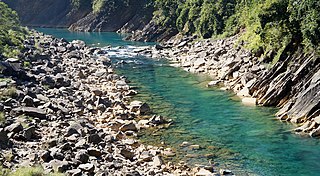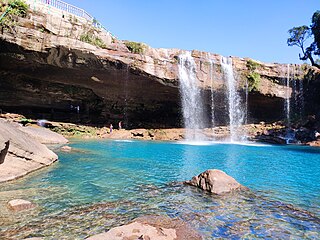Related Research Articles

Meghalaya is a state in northeast India. Meghalaya was formed on 21 January 1972 by carving out two districts from the state of Assam: (a) the United Khasi Hills and Jaintia Hills and (b) the Garo Hills. The estimated population of Meghalaya in 2014 was 3,211,474. Meghalaya covers an area of approximately 22,429 square kilometres, with a length-to-breadth ratio of about 3:1.
Jaintia Hills District was a district in Meghalaya, India that was established in 1972 with headquarters at Jowai which was taken from the United Khasi Jaintia Hills District Council. It was once part of the ancient Jaintia Kingdom. The present inhabitants of the District are the Pnar, the War, the Bhoi (Karbis), Tiwa (Lalung) and the Biates In 2012 the district has been bifurcated into two districts:-

Ri Bhoi is an administrative district in the state of Meghalaya in India. The district headquarters are located at Nongpoh. The district occupies an area of 2378 km² and has a population of 258,840. As of 2011 it is the second least populous district of Meghalaya, after South Garo Hills.

The Karbis or Mikir are one of the major ethnic community in Northeast India. They are mostly concentrated in the hill districts of Karbi Anglong and West Karbi Anglong of Assam.

The Khasi Hills are a low mountain formation on the Shillong Plateau in the Meghalaya state of India. The Khasi Hills are part of the Garo-Khasi-Jaintia range and connect with the Purvanchal Range and larger Patkai Range further east. The Khasi Hills, and the whole Garo-Khasi-Jaintia range, are in the Meghalaya subtropical forests ecoregion.

Jowai is the headquarters of the West Jaintia Hills district of the state of Meghalaya, India, and is home to the Pnar, a sub-tribe of the Khasi people. It is located on a plateau surrounded on three sides by the Myntdu river bordering Bangladesh to the south. Due to its high altitude of 1365 m above sea level, Jowai experiences warm summers with cool to chilly winters.

The Jaintia Kingdom was a kingdom in present-day some parts of Bangladesh's Sylhet Division, India's Meghalaya state and Nagaon, Morigoan district of Assam. It was partitioned into three in 630 AD by Raja Guhak for his three sons, into the Jaintia Kingdom, Gour Kingdom and Laur Kingdom. It was annexed by the British East India Company in 1835. All the Pnar Rajahs of the Jaintiapur Kingdom are from the Syiem Sutnga clan, a Pnar clan of the Khasi tribe which claims descent from Ka Li Dohkha, a divine nymph.
The Pnar, also known as Jaiñtia, are a sub-tribal group of the Khasi people in Meghalaya, India. The Pnar people are matrilineal. They speak the Pnar Language, which belongs to the Austro-Asiatic language family and is very similar to the Khasi language. The Pnar people are natives of West Jaintia Hills and East Jaintia Hills District of Meghalaya, India. They call themselves as "Ki Khun Hynñiew Trep". Their main festivals are Behdeinkhlam, Chad Sukra, Chad Pastieh and Laho Dance.

The Aimol people are an ethnic group living mainly in Manipur and in parts of Mizoram, Tripura, Nagaland and Assam,Meghalaya in India. They speak Aimol language which is a Kuki-Chin language. They identify themselves as 'Aimol' an independent tribe with no affiliates. Aimols have continued to live in harmony with neighboring communities before the independence and to this day. Aimols are closely related to Kom, Koireng, Chiru, Chothe,khelma,Biete,Biate etc. They use Meitei language as their second language (L2) according to the Ethnologue.

The Khelma, also known as the Sakachep are one of the Old Kuki tribes of northeastern parts of India.

The Karbi language is spoken by the Karbi people of Northeastern India.
The Kuki-Chin-Mizo languages are a branch of the Sino-Tibetan language family spoken in northeastern India, western Myanmar and southeastern Bangladesh. Most notable Kuki-Chin-speaking ethnic groups are referred to collectively as the Zo people which includes: the Mizo of Mizoram, the Kuki of Manipur, Assam, Nagaland, Tripura and Bangladesh and the Chin of Chin State, Myanmar.

The Khasi and Jaintia Hills are a mountainous region in India that was mainly part of Assam and Meghalaya. This area is now part of the present Indian constitutive state of Meghalaya, which includes the present districts of East Jaintia Hills district, headquarter Khliehriat, West Jaintia Hills district, headquarter Jowai, East Khasi Hills district, headquarter Shillong, and West Khasi Hills district, headquarter Nongstoin.

The Biates are an ethnic hill tribe of Assam, Meghalaya, Mizoram, Tripura and Manipur. Their language belongs to the Tibeto-Burman family. Spread over many parts of North-East India, they have a unique identity with a rich and distinctive history, culture, dialect and religious heritages. They are one of the oldest hill tribes of North East India especially among the Chin-Kuki-Mizo people. The term Biate comes from the word Bia-te. The word ‘Bia’ or ‘Biak’ means ‘speak’ or ‘worship’. ‘Te’ is a suffix denoting plurality. Hence, the two words combine to form the word Biate, which means worshipper.
Sakachep also known as Khelma, is a Central Kuki-Chin-Mizo language of Northeast India. Dialects are Khelma, Thangachep, and Sakachep (Ethnologue). VanBik (2009) classifies Sakachep as closely related to Aimol, Anal, Chiru, Kharam, Koireng(Koren), Kom, Lamkang, Purum, Biate, Chorei, Ranglong, Molsom, Hrangkhol, Kaipeng, Bongcher and Thiek-Hmar.
Rabha is a Sino-Tibetan language of Northeast India. The two dialects, Maituri and Rongdani, are divergent enough to cause problems in communication. According to U.V. Joseph, there are three dialects, viz. Róngdani or Róngdania, Mayturi or Mayturia and Songga or Kocha. Joseph writes that "the Kocha dialect, spoken along the northern bank of the Brahmaputra, is highly divergent and is not intelligible to a Róngdani or Mayturi speaker". Joseph also writes that "[t]he dialect variations between Róngdani and Mayturi, both of which are spoken on the southern bank of the Brahmaputra, in the Goalpara district of Assam and belong to the northern slopes of Meghalaya, are minimal". He concludes the paragraph on dialectal variation with: "The Róngdani-Mayturi dialectal differences become gradually more marked as one moves further west".

East Jaintia Hills district is a district with its headquarters at Khliehriat in Meghalaya state of India. The district was carved out of Jaintia Hills district on 31 July 2012.

West Jaintia Hills is an administrative District in the state of Meghalaya in India. The united district was created on 22 February 1972 and occupied an area of 3819 km2. It had a population of 272,185. The district is part of the Meghalaya subtropical forests eco-region. With the bifurcation of the erstwhile Jaintia Hills District into East and West Jaintia Hills Districts, West Jaintia Hills District came into existence on 31 July 2012 with its headquarters at Jowai. Jowai is the host of all the heads of important governmental offices and establishments, educational institutions, hospitals, banking institutions, etc.
Saipung is a village in East Jaintia Hills district, Meghalaya, India. It is the headquarters of the Saipung Sub-Division. The population was 1,431 as per the 2011 Indian census. Located about 136 km from the state's capital Shillong, Saipung is inhabited by the Biate people.
Lungzubel which means "Stone rice beer containers or jars" in the Biate language are stone relics found in the southwestern part of Dima Hasao district in Assam and its surrounding areas extending to the neighboring state of Meghalaya.
References
- ↑ Biate at Ethnologue (25th ed., 2022)

- ↑ Lalsim, R. (2005). Tribes of N.C.Hills, Assam. Assam: Cultural and Publicity Officer. pp. 61–105.

